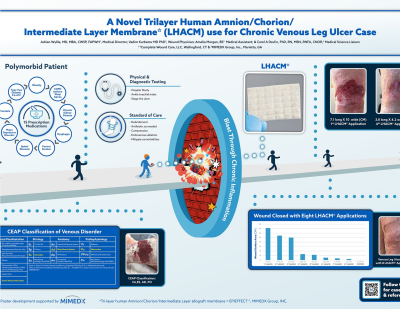Practice Innovations
(PI-048) A Novel Trilayer Human Amnion/chorion/intermediate Layer Membrane* Use for Chronic Venous Leg Ulcer Case

Venous leg ulcers (VLU) affect 1% to 2% of the population and the incidence increases with age affecting approximately 4% of those older than 65 years.1 Because VLUs have a high chronicity and recurrence rate and slow healing time, they accounts for 80%2 of all leg ulcers.
VLUs are known to impact a patient's quality of life from pain, swelling, and exudate leakage, which leads to psychological distress including embarrassment, social isolation, depression, and anxiety. VLUs impact the inflicted person’s mobility and daily activities due to the limitations from the wound and associated symptoms.
Per CMS3 and CAMPs4 guidelines, after four weeks of standard of care, with less than 50% surface area reduction, wounds, including VLUs, are considered chronic. Current recommended guidelines suggest that advanced therapies including placental-based allografts be considered for chronic wounds.3,4 LHACM, a new, novel tri-layer placental-based allograft intended for deeper and complex wounds, is presented in this case study. We submit a Venous Leg Ulcer (VLU) case where a novel trilayer human Amnion/Chorion/Intermediate Layer Membrane* (LHACM), was employed to support the chronic wound closure.
Methods:
A 70-year-old polymorbid female presented with a chronic VLU. The chronic VLU wound was treated with standard of care and eight LHACM applications, which adheres to the new LCD allograft allowance.
Results: The chronic VLU wound closed in 3 months.
Discussion: This case represents foundational evidence support use of LHACM, a novel trilayer human Amnion/Chorion/Intermediate Layer Membrane* treatment. Building evidence is important to support its continued use for chronic VLUs. Solutions to close chronic wounds including VLUs are needed to help these patients physically and psychologically.

.jpg)